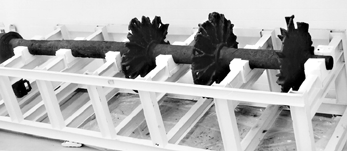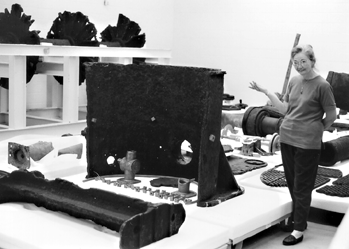
12,000 Years of History in Storage on the Patuxent
by Carol Glover
Maryland's Attic
12,000 Years of History in Storage on the
Patuxent
by Carol Glover
1850: Steamboat Columbus Sinks
On Nov. 28, the 174-foot steamboat Columbus ended its weekly trips from Baltimore to Norfolk. At three o'clock on that windy afternoon at the mouth of the Potomac River, flames shot from the furnace of the giant steamboat and torched the woodpile; the decking and other timbers ignited. The burning continued throughout the night. Smoke still hung in the air the next morning. By 11am, the rough waters had closed over the wreckage. Nine people and five horses were lost, as was its cargo of timber, cotton and tobacco and the cross-head steam engine designed by Charles Reeder.
After a quarter-century, the Columbus entered the log of Maryland's maritime
history.
1991:The Columbus Rediscovered
One hundred forty years later, the Army Corps of Engineers dredged a channel from the Chesapeake Capes in Virginia to Baltimore. At the mouth of the Potomac, they found the site of a shipwreck: Not unusual for this area, except that this shipwreck contained a steamboat's entire unbroken engine. In the 60-foot, silted waters, divers measured the parts and matched them to the Columbus.
During the summer of 1992, David Holly -- Maryland's foremost authority
on steamboats -- watched as "the Corps' contractors, U.S. army reservists
and divers hoisted engine pieces from the murky waters to the surface."
The parts sticking into the channel were excavated: The 23-foot paddle wheel shaft, weighing 15 tons; the four-foot diameter cylinder; and the piston, rod, steam chest and other assorted parts were loaded on barges and shipped to Curtis Bay in Baltimore. Those parts not intruding upon the shipping channel were left on site.
Since the Potomac River is Maryland's territory, the steamboat Columbus belonged to the state. However, Maryland had nowhere to restore and conserve the find. So the dismembered steamboat engine journeyed by truck to the nearest lab: the International Artifact Conservation and Research Laboratory in New Orleans.
With 12,000 years and five million bits and pieces of history to store, Maryland's attic needs to be bigger than most ...
If you drive back-country Mackall Road, you'll see the old and new of Calvert County: horse farms and tobacco barns, magnificent Patuxent riverviews and old farmhouses alongside slashes of new development. You seem so deep, so securely in the country that you hardly expect to come upon one of the nation's most technologically advanced conservation and preservation labs.
Green and white signs point you onto the grounds of the Jefferson Patterson Park and Museum, which preserves the story of Maryland's farming history as far back as Native Americans. The long, windy gravel driveway, meandering beneath tall pines and giant hardwoods, leads to a spectacular view of the Patuxent River. Looming on your left, a series of giant white and gray triangles cut the skies. Here, sprawled in the midst of Calvert County bottomland and surrounded by farms, stands the Maryland Archaeological Conservation Laboratory, one of the nation's most technologically advanced conservation and preservation labs.
Built with cypress siding and tin roof to resemble the Park's other Colonial Revival-style outbuildings, the award-winning 1998 building houses over five million artifacts from Maryland's 12-millennium history. The collection spans ocean to mountains.
"We need a sense of place. We need to be reminded that we are a current generation of past generations," explains native Marylander Wayne Clark, who as executive director of Maryland's Office of Museum Services, oversees the lab. "People have lived in Maryland for over 12,000 years. We plan to unlock the stories of the past and tell them by making artifacts available to history museums around the state."
Tripping off Clark's tongue, the mission sounds simple. In fact, it's a mission easier said than done, as you'll see in the story of the steamboat Columbus.
1997
On a wintry December afternoon, the Columbus came back to Maryland.
"I answer the phone," says Betty Seifert, who is Maryland Archaeological Conservation Lab's chief conservator. "It's the International Conservation and Research Laboratory in New Orleans. They need to ship us the Columbus' parts.
"'We can't do this,' I say. 'We don't have a building.' But the parts are on their way.
"We could not wait for the formal dedication, set for May, so on January 27, 1998 the building was turned over to us so we could receive the Columbus' engine."
As a tractor trailer loaded with 20 crates and a paddle wheel journeyed up the East Coast, the lab staff waited. Anxiously.
1998
At the 12-foot high receiving door of the Maryland Archaeological Conservation Laboratory, the heavily loaded truck arrives on a frosty afternoon in January. A rented 30-ton crane unloads the crates. But the wooden cradle holding the massive iron paddle wheel and shaft breaks.
 The paddle wheel and shaft, covered in plastic
sheets, waited in the driveway from February to June while Jerry's Welding
in Prince Frederick constructed a new steel cradle.
The paddle wheel and shaft, covered in plastic
sheets, waited in the driveway from February to June while Jerry's Welding
in Prince Frederick constructed a new steel cradle.
Meanwhile, a palette jack and forklift muscled the remains of Columbus' crosshead engine through the lab and into the conservation room.
"Each crate containing Columbus' parts came with a list containing a general description of the pieces and the treatment given," Seifert explained.
Earlier in New Orleans, the 15-ton paddle wheel shaft, the four-foot diameter cylinder and the piston, rod and steam chest were "conserved." Section by section, they were submerged in huge tanks of sodium hydroxide. Electrolytic reduction loosens concretion - a concrete-like substance deposited by metal salts and sea minerals in the century and a half the Columbus lay underwater. The metal pieces were mechanically picked, cleaned, resoaked and cleaned again. Such a job takes about three years. After that, you've got tons of perfectly restored 18th-century steam engine.
Conservation like that is the business of the Maryland Archaeological
Conservation Laboratory, now that it's up and running.
"Having the Columbus here at the beginning would have been a great opportunity for the lab. It's exciting to work on the kind of project the lab is made for," said Mike Smolek, director of Jefferson Patterson Park and Museum. But, he noted, "we have thousands and thousands of artifacts that need work. Two 18th-century cannons just found in the ballast of the Constellation [the 18th-century sloop of war now under private restoration at the Fort McHenry Shipyard] will be coming here."
Instead, our local researchers and conservators' first from-the-depths restoration was the 340-pound helm from the CSS Alabama, a Confederate raider sunk off the coast of France in 1864. On our lab's team are Julie King, chief of Archaeological Services; Ed Chaney, director of research; and underwater archaeologist Susan Langley. Meanwhile other sections of the lab are at work on animal bones, buttons, coins, old shoes and early 18th-century witches bottles.
Before the Maryland Archaeological Conservation Laboratory was built, all those artifacts were in temporary storage, first in the State Highway Administration in Baltimore, then at both the Hall of Records in Annapolis and Spring Grove Mental Hospital.
All of this wonderful stuff -- from massive steam boat drive shafts to
fragile old bones -- moves from the research and conservation sections of
the laboratory to its collection management/storage area. Three floors high
and covering about a third of a football field, it's like a giant attic
stuffed full of great old things somebody would just love to have.
Keeping artifacts safe yet available for study is quite a trick. All five million artifacts are computer tracked so that staff and visiting scientists can locate each at a given moment. The iron and copper engine pieces are stored in a humidity- and temperature-controlled room. Resting on foam palettes, the Charles Reeder crosshead engine pieces stretch across the floor of the storage area.
It's time to find a home where people can enjoy seeing these maritime relics -- and make room for other artifacts.
"The lab is a behind-the-scenes operation. We're responsible for 100 percent of the state's artifact conservation, 95 percent of the research and 99 percent of its storage. We want the artifacts we've conserved to end up in a museum for display and education," said Maryland's Museum Services director Clark.
1999: Wanted
A good home, with public access, to display the last remaining crosshead engine. Needed: a stable, climate-controlled museum environment, exhibition and interpretive plans, adequate financing, lots of space and TLC. Phone: 410/586-8550.
This is one phone call Betty Seifert can't wait to get.
The best way to appreciate this $7 million Maryland house of science is to take a tour. Tours are given the first Friday of every month: 410/586-8550.
To learn more about the Columbus, as well as other Chesapeake steamboats, read David C. Holly's Chesapeake Steamboats: Vanished Fleet, Steamboat on the Chesapeake: Emma Giles and the Tolchester Line and Tidewater by Steamboat: A Saga of the Chesapeake.